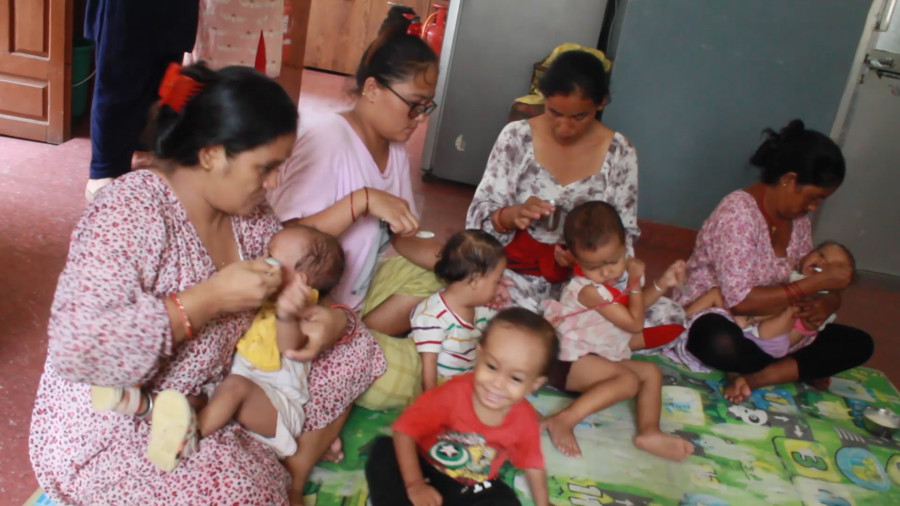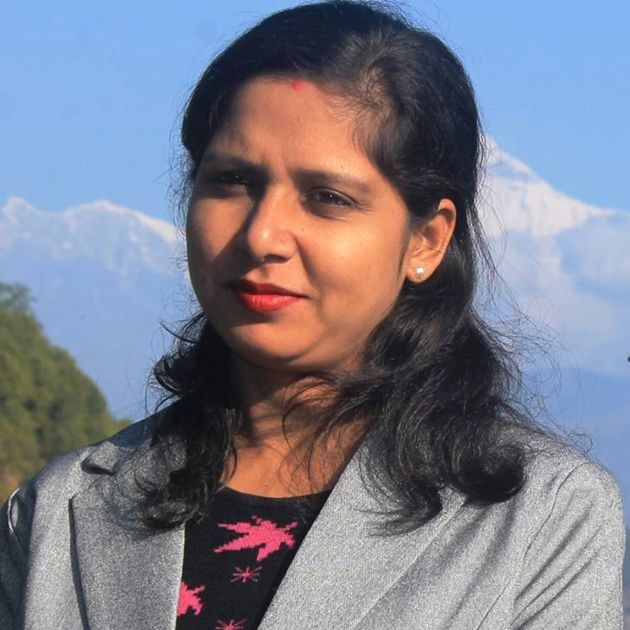Lumbini Province
Children, mothers in Lumbini suffer from malnutrition
Gaps in public health awareness have turned malnutrition into a serious problem.
Amrita Anmol
Goma Saru’s one-year-old son weighs 5.9kg. The infant does not have an appetite and vomits every time he’s fed. He suffers from bouts of fever and diarrhoea. A month ago, his 17-year-old mother took him to Chhahara Health Post, the local health post at Rainadebi Chhahara-4 in Palpa. The health workers at the facility diagnosed the infant with severe malnutrition and referred him to the Nutrition Rehabilitation Home in Butwal for treatment.
The infant has been receiving treatment at the rehabilitation home for the past one month.
Like her son, Goma too suffers from malnutrition. Married at the age of 15, Goma gave birth to her baby boy a year later. She is 17 and her body weight is 35kg.
“When I took my baby to the rehabilitation home, they told me I am also malnourished. I did not know that my baby and I both were extremely unhealthy,” said Goma. “I was not aware of the nutrition requirement for my baby and me. He has been a sickly child since his birth.”
Twenty-year-old Sapana Pun from Purtighat in Kaligandaki Rural Municipality, Gulmi, has an 11-month-old daughter. The infant is feeble; she hardly eats and cries all the time. She has a swollen stomach and is always down with a fever. The mother took her child to the rehabilitation home in Butwal a month ago where the infant is receiving treatment for malnourishment.
“My daughter’s health is improving since the treatment. She is eating nutritious food and is on a balanced diet,” said Pun.
According to the World Health Organisation, malnutrition refers to deficiencies or excesses in nutrient intake, imbalance of essential nutrients or impaired nutrient utilisation. The double burden of malnutrition consists of both undernutrition and overweight and obesity, as well as diet-related noncommunicable diseases.
“Malnutrition among children and mothers is mainly caused due to the lack of breastfeeding to the newborn, dependency on processed and packaged food and lack of awareness of eating and feeding habits,” said Netra Rana, a paediatrician at Lumbini Provincial Hospital. According to him, malnutrition affects children’s physical as well as mental growth which in turn undermines the country’s public health. Malnutrition weakens intellectual capacity, limits productivity in adulthood, and increases vulnerability to certain diseases, say experts.
The gaps in public health awareness has turned malnutrition into a serious problem in Lumbini province. Most people are unaware of malnutrition among children and fail to recognise the symptoms for timely treatment. Pregnant women and nursing mothers also suffer from malnutrition.
There is only one nutrition rehabilitation home in the Lumbini province. The Nutrition Rehabilitation Home in Butwal can provide treatment to 10 malnourished children at a time.
“Malnourished children from six months to five years of age and their mothers are kept at the nutrition home for treatment. The mothers are also taught to prepare nutritious foods for themselves and their children,” said Parbati KC, a nurse at the nutrition rehabilitation home. According to her, around 150 children suffering from malnutrition receive treatment from the nutrition home in a year.
Lumbini Province, which comprises six Tarai and six hill districts, has relatively better infrastructure development than some other provinces. However, the child and maternal health status is lower than the national average.
According to a preliminary report of the Nepal Demographic and Health Survey-2022, stunting decreased from 57 percent in 2001 to 25 percent in 2022 in Nepal. While the country has made progress in reducing stunting among children under five, as many as 25 percent of children in Lumbini are stunted. Likewise, wasting, a debilitating disease that causes muscle and fat tissues to waste away among children under five, decreased from 11 percent in 2001 to eight percent in 2022. However, the wasting percentage stands at 16 in Lumbini province.
A recent study conducted by the Lumbini Health Directorate shows that child marriage and teen pregnancy, poverty, a lack of awareness about nutritious food are the leading causes behind the alarming rate of malnutrition among children and women in Lumbini.
According to the Nepal Demographic and Health Survey-2022, Lumbini has the second lowest rate of anaemia in the 15-49 age group of women among seven provinces of Nepal. As many as 44 percent women of the age group are suffering from anaemia in Lumbini and 52 percent in Madhesh province. Similarly, 19 percent of women of the same age group are suffering from wasting, the third lowest after Madhesh and Karnali.
The data of the Health Ministry of Lumbini province shows a total of 74 women died during pregnancy and postpartum period in the province in the last fiscal year of 2022-23. Twenty-eight of them suffered from anaemia. “Anaemic women can suffer from haemorrhage during pregnancy and even during the postpartum period. Excessive bleeding may lead to death,” said Sunita Gywali, a nursing officer at the ministry.
Despite the alarming number of malnutrition cases in women and children in Lumbini, the provincial government has yet to take concrete steps to mitigate the health issue.
According to women and children’s health activist Gyanu Paudyal, governments at all levels have failed to address the issues despite being aware of the situation. Besides some initiatives taken by the local governments, the authorities are yet to take significant measures to reduce malnutrition, stunting, wasting and anaemia among pregnant women, young mothers and their children.
According to Health Director Binod Kumar Giri, the local government distributes ‘pregnancy nutrition kits’ to pregnant women. The programme was introduced with the aim of improving the nutritional status of mothers and babies and safeguarding their health, Giri said.
The kits, which include half kgs of satu (a multi-grain flour), are distributed free of cost to all pregnant women who seek medical assistance in government-run health offices. The flour is made of a mixture of rice, wheat, corn, barley, wheat flour, chickpeas, and dairy products, and will last a month if taken 100 grams per day.
“This improves the immunity of the mother, increases lactation, and prevents the babies from getting malnourished,” Giri added. The local government has also decided to take initiatives to spread awareness about nutrition and improve eating habits through various health programmes.
The lack of nutrition in food intake is a major reason for women and children being malnourished in the province, says Luvhari Budhathoki who works in public health and nutrition. Growing children should be fed nutritious food and be administered deworming medicine to reduce diarrhoea incidences, says Budhathoki.
Pratiksha Thapa, in charge of Butwal’s child nutrition rehabilitation home, says that a change in eating habits should be practised for the health and safety of women and children.
“We should eat at least four times a day,” Thapa said. “Instead of instant ready-made food, one should opt for homemade snacks, seasonal fruits, pulses, green vegetables, fish, meat, eggs and milk.”




 17.12°C Kathmandu
17.12°C Kathmandu










